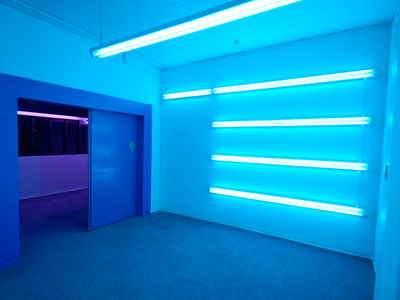
Ask the AI Tutor
Need help with Electricity - Currents in Electrical Circuits? Ask our AI Tutor!
AI Tutor - Lucy
Connecting with Tutor...
Please wait while we establish connection

Fluorescent bulbs create a large potential difference between two electric plates.
Electricity - Currents in Electrical Circuits
Explore how electric current flows in series and parallel circuits, how components affect current, and how circuit diagrams help you understand and solve GCSE Physics questions.
1 .
If two components are connected in series, how is the potential difference across each split?
It is dependent on which components are used.
It is dependent on the resistance of the components used.
One component gets twice as much voltage as the other.
They are the same.
Current, potential difference and resistance are closely linked. Each one depends on the value of the others
2 .
What is the current through a circuit which contains three resistors of size 3 Ω, 5 Ω and 7 Ω respectively which are placed in series when a potential difference of 12 V is applied?
0.8 A
1 A
2 A
10 A
V = I multiplied by R so rearranging the equation gives I = V divided by R. The resistors are in series so the total resistance to use in the equation is the sum of the three individual resistors
3 .
Why does a 60 W equivalent fluorescent bulb use less energy than a 60 W filament bulb?
The electrons flow through the fluorescent bulb at a smaller voltage which reduces the energy used
The electrons flow through the fluorescent bulb with a smaller current, thus reducing the energy used
The fluorescent bulb has a smaller resistance than the filament bulb
They use the same amount of energy
Fluorescent bulbs create a large potential difference between two electric plates. The space between the plates is filled with an inert gas and when an electron gains enough energy to travel from one plate to the other, it can collide with the gas in the bulb. This creates an 'avalanche effect' where electrons are knocked out from the outer electron shells of the inert gas. The electrons are then absorbed by another atom and this process emits a photon of light. When the photons of light strike the coating on the inside of the bulb, the coating fluoresces, giving out light
4 .
What is the definition of current?
Flow of atoms through a circuit
Flow of electrons through a circuit
The amount of resistance an electron experiences when travelling through a circuit
The energy which each electron has when flowing through a circuit
Metals are the best conductors of electricity because of metallic bonding
5 .
Two circuits are set up and both circuits contain two bulbs. One circuit is set up so that the bulbs are connected in series, whilst the other is set up so that the bulbs are connected in parallel. In which circuit will the bulbs be brightest if both circuits have the same resistance and the same voltage applied?
Circuit in parallel
Circuit in series
They will both have the same brightness
It is impossible to tell
Placing components in parallel reduces the resistance which each electron has to travel through to get to the positive anode of the cell, resulting in a larger current through each component
6 .
What is the total resistance in a circuit if the potential difference is 12 V and the current flowing through the circuit is 3 A?
2 Ω
3 Ω
4 Ω
5 Ω
V = I multiplied by R so rearranging the equation gives R = V divided by I
7 .
If the voltage in a circuit is increased whilst the resistance remains constant, what will happen to the current in the circuit?
Current decreases
Current increases
Current remains the same
Values for the voltage and resistance are required to answer this
Current and voltage are directly proportional
8 .
If the voltage in a circuit remains constant but the resistance is increased, what will happen to the current?
Current decreases
Current increases
Current remains the same
Values for the voltage and resistance are required to answer this
The current and resistance are inversely proportional
9 .
Calculate the current in a circuit when the voltage of the circuit is 5 V and the circuit has a total resistance of 5 Ω.
1 A
2 A
10 A
25 A
V = I multiplied by R so rearranging the equation gives I = V divided by R
10 .
Two 2 Ω resistors are placed in parallel in a circuit. If the potential difference supplied to the circuit is 10 V, what size is the current which passes through each resistor?
5 A
10 A
20 A
40 A
Since the resistance is the same in the two parts of the parallel circuit, the current splits evenly. You can prove this to yourself by calculating from V = I R
**Unlimited Quizzes Await You! 🚀**
Hey there, quiz champ! 🌟 You've already tackled today's free questions.
Ready for more?
Ready for more?
🔓 Unlock UNLIMITED Quizzes and challenge yourself every day. But that's
not all...
not all...
🔥 As a Subscriber you can join our thrilling "Daily Streak" against other
quizzers. Try to win a coveted spot on our Hall of Fame Page.
quizzers. Try to win a coveted spot on our Hall of Fame Page.
Don't miss out! Join us now and keep the fun rolling. 🎉
**Unlimited Quizzes Await You! 🚀**
Hey there, quiz champ! 🌟 You've already tackled today's free questions. Ready for more?
🔓 Unlock UNLIMITED Quizzes and challenge yourself every day. But that's not all...
🔥 As a Subscriber you can join our thrilling "Daily Streak" against other quizzers. Try to win a coveted spot on our Hall of Fame Page.
Don't miss out! Join us now and keep the fun rolling. 🎉






